WHAT IS IT?
A ginger bug is a wild ferment made from ginger, sugar, and water. After cultivating the natural yeast on the ginger, within a week, a bubbly concoction is made. Its full of yeast and probiotics, similar to a sourdough starter, that we can use to make homemade soda. A small amount of ginger bug is added to your soda base (juice, tea, etc.), and within a few days of letting the soda ferment at room temperature in a pressure safe bottle, you’ll have homemade soda that is full of probiotics and tailored to your preferences!
HOW TO MAKE IT:
Day 1: add 2 tablespoons of chopped ginger (keep skin on as there’s lots of yeast and bacteria on it that we want to cultivate), 2 tablespoons sugar, and 2 cups of water into a jar. Cover with coffee filter or paper towel secured with a rubber band and place into a dark place overnight Day 2: add 1 tablespoon chopped ginger and 1 teaspoon sugar to your ginger bug. Be sure to give it a good stir at least twice per day to ensure that the top layer of ginger is not exposed to air for too long, as that can increase your chances of mold. Keep at room temperature and away from direct sunlight. You might see some bubbles starting to form at this stage, that’s a good sign! Day 3-10ish: Repeat day 2 procedure. Your ginger bug will probably go cloudy and possibly even stop producing bubbles for a few days. This is normal, it’s going through a phase called a microbial shift where some of the weak yeast strains start to die off and the strong ones are multiplying. We want that. It’s not dead, just continue feeding it until it starts producing bubbles after every feeding. Cloudiness is also normal. This process might take 5 days, or 10 days of feeding and monitoring, depending on your climate and environment. After it starts producing bubbles consistently, your ginger bug is ready and you can use it to make homemade sodas!
THINGS TO NOTE:
If your ginger bug starts smelling off, then it probably is. Use your instincts and your sense of smell to determine if it’s gone bad. If you see any visible mold on top, then discard your ginger bug and try again. Mold usually floats on top, its fuzzy and either white, gray or maybe even black spots.
The ideal temperature for making a ginger bug is around 70-75 degrees Fahrenheit. If it’s too warm, your ginger bug can get thick or develop mold. You can try wrapping a wet towel around your ginger bug to help keep it cool. If it’s too cold, your ginger bug might have a hard time fermenting. In that case, try finding a warmer area in your house to help your ginger bug ferment.




